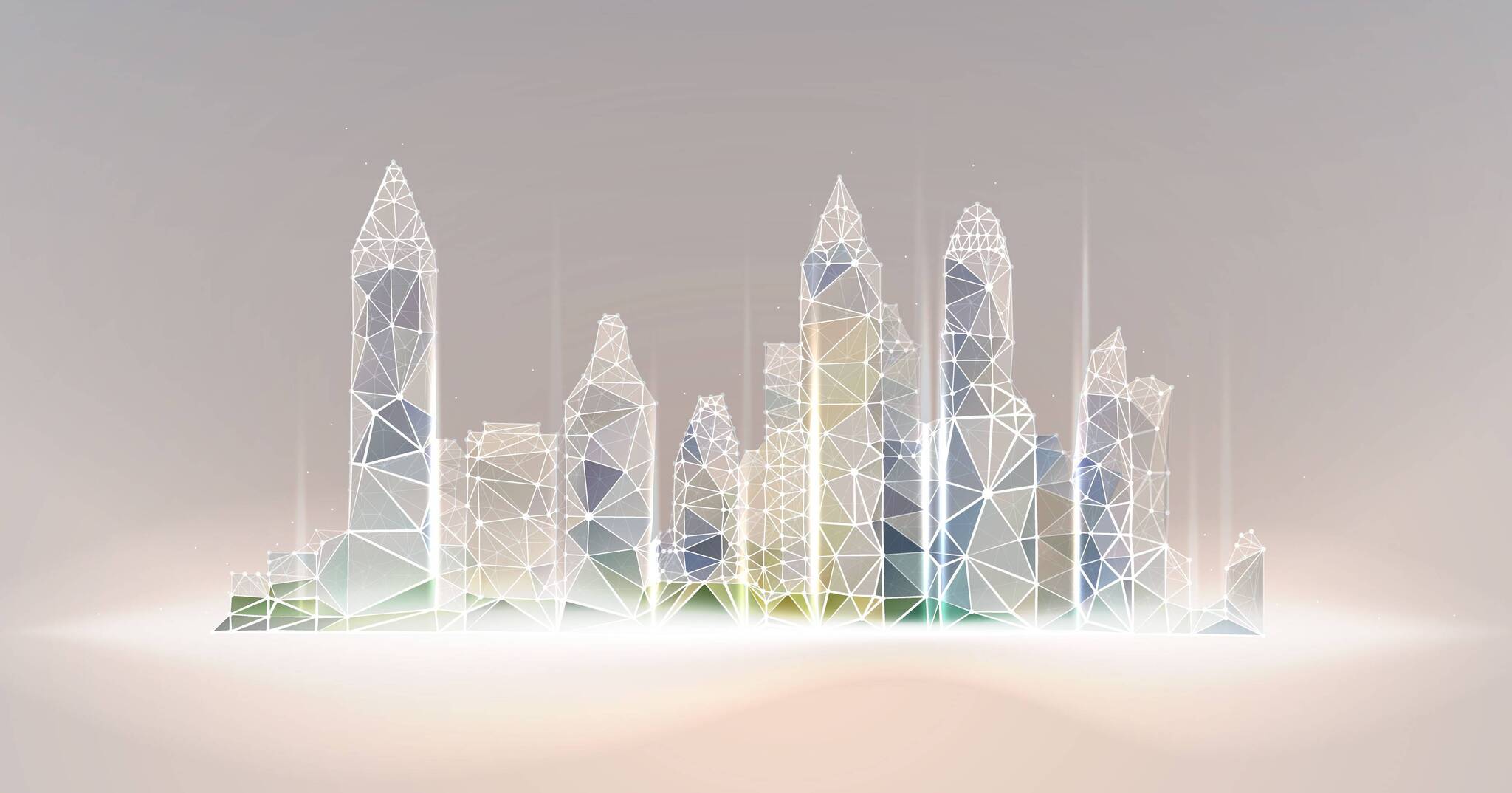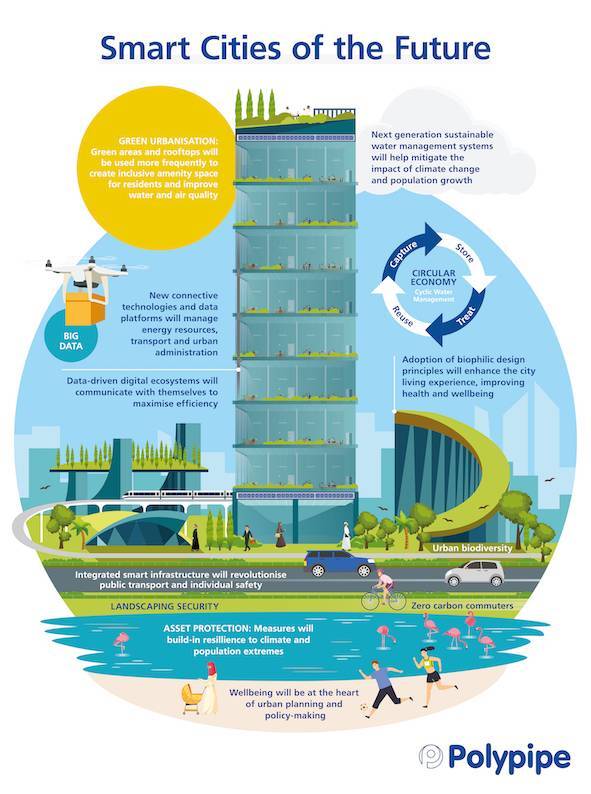Permavoid Shallow Geocellular Water Management System
Permavoid is our award-winning water management solution, designed to provide shallow water storage for attenuation, detention or soakaway/inf

Approximately 55% of the entire global population inhabit cities. In fact, a total of 1.3 billion people is migrating into cities around the world every week.[1]
Fortunately, today’s cities are the heart of innovation and economic growth. Whilst the rapidly growing urban population places a significant stress on a city’s infrastructure and environment, cities are now adapting the way they operate through inspiring and innovative solutions which seek to accommodate growing populations in a more intelligent, efficient and environmentally conscious manner.
This is where the idea of ‘The Smart City’ comes in.
How Will Future Cities Become ‘Smarter’?
1) Circular Economy
The truth is that with a growing population, comes increased water usage and wastage. Consequently, more cities are looking to a circular economy model to find more successful ways to manage water and reduce waste.
This kind of economic system is based on 3 key ideas:
A cyclic approach to water management that replicates the natural water cycle of capture, store, treat, and re-use is now being more widely employed; in particular, to address the growing threat of water scarcity in many cities. Furthermore, cities are placing increased focus on designing systems that use rainwater run-off to naturally infiltrate soil, rather than channelling it into pipes and storm drains that actually increases flood risk.
2) Urban Resilience
The idea of Urban Resilience represents the ability of any urban system to survive and grow through shocks and stresses, while also positively adapting to encourage sustainability.
This approach involves embracing more sustainable materials and utilizing available natural resources more productively.
Dutch water expert, Henk Ovink, says, “If we only respond to the past, we will only get answers that fit the past.”[2] Luckily, smarter solutions that encourage urban resilience are gaining increased recognition.
For example, traditional stormwater systems transport rainwater run-off into underground pipes to carry it away from buildings as far and fast as possible, eventually disposing of it into large bodies of water. Unfortunately, these systems can be overpowered by significant volumes of water. Run-off water often collects pollutants and eventually erodes stormwater systems and the surrounding landscape.
We now notice a shift towards the use of more sustainable materials and systems. Drainage and piping systems are increasingly fashioned from sustainable plastics and are designed specifically, to save energy, reduce noise and encourage water reuse.
We use Sustainable urban Drainage Systems (SuDs) - a forward-thinking approach to managing water in an urban environment that closely mimics the natural water cycle and can be used to replace artificial drainage methods. Our engineered solutions, specifically Permavoid and Polystorm, can help your project’s profitability.
Learn more about how our SuDs solutions can benefit your project here.
3) Data-Driven Ecosystem
Big Data is the new currency. The widespread integration of smart data to asses city patterns and inefficiencies is fundamental to improving quality of life and minimizing environmental damage. New connective technologies and data platforms will manage energy resources, transport and urban administration.
The Internet of Things (IoT), which refers to the eventual ability for all devices connected to the internet to communicate and share data, can be integrated into daily water, waste and resource management systems to increase efficiency.
The use of integrated IT-based data has been effective in various ways. For example, a data-driven approach can be applied to incorporating smart technologies into initiatives to reduce air pollution.
An increase in the use of Artificial Intelligence-assisted (AI) platforms has achieved some success in this area. These technologies collect and analyse data concerning weather and traffic commuter information to predict areas of poor air quality. Local governments can then use this information by controlling traffic and factory emissions in more gravely affected areas.
IT-based solutions are also growing more popular in the water management industry. The control and management of water from remote locations is actually possible via cloud-based control systems, which can be used to optimize irrigation, water storage and water use. These intelligent water management systems enable remote monitoring and control of the system, adjust water levels based on weather forecasting, control water usage based on individual needs and more.
4) Green Urbanisation
Green Urbanisation refers to the increased incorporation of green spaces to create communities that are more beneficial to both humans and their environment.
In recent years, there has been a significant rise in the construction of parks, green spaces and green/living roofs, which ultimately seek to cool the environment, manage resources in a more sustainable way, enhance well-being and increase urban biodiversity.
Green/ living roofs have proven to be particularly effective in transforming unused spaces into beautiful and ecological zones for effective water management.
Green/Living roofs are an intelligent way to utilise the flat, empty roofs of urban buildings. Vegetation is incorporated into these spaces, which then absorbs rainwater to grow. These roofs help to reduce energy costs through natural lining, create peaceful spaces for city dwellers and lessen the need for more complex and expensive drainage systems. You can discover more about green/living roofs from our last blog.
We believe a key aspect of sustainable water management is keeping stormwater as close to where it falls as possible. Our geocellular water management tool Permavoid is strong, durable and ideal for use in projects that allow for more eco-friendly water management, like green/living roofs.
5) Asset Protection and Creation
Asset Protection is the practice of protecting and enhancing the use of existing infrastructure and natural resources to improve the quality of urban life. New assets, for instance, well-being focused amenities and placemaking, can also be created to enhance urban life.
This approach is being more widely adopted by the water sector as a means to achieve a more sustainable infrastructure. If water is embraced as a natural capital, initiatives to decrease water usage, such as urban farming, could increase.
Furthermore, the addition of new, greener spaces in urban areas has been proven to positively affect physical and mental health and transform cities and neighbourhoods into more attractive places to live and work.
These community spaces can even double up as an efficient water management solution. In the Netherlands, natural ecological systems were being overpowered by the man-made structures built to control flooding. As a result, a strategy nicknamed ‘Making Room for the River’ was adopted. This involved giving more space to rivers so they could swell naturally and accommodate extra water during storms. These areas were then turned into parks and public amenities for non-stormy seasons.

The population is expected to rise and so it is inevitable that our cities will face a complex web of challenges as they grow. Almost 200 countries say that smart city technology is vital to success for future growth.[3] The key for environmental, social and economic sustainability seems to focus on keeping up with new technologies and techniques that embrace sustainability.
Contact us today to discuss how our expertise and solutions can support the development of smart cities and more intelligent water management the transformative solutions for your project:
Tel: +971 (0) 4 518 3000
Email: middleeast@polypipe.com
Permavoid is our award-winning water management solution, designed to provide shallow water storage for attenuation, detention or soakaway/inf
Polystorm is an efficient and versatile geocellular water management system for Sustainable urban Drainage Systems (SuDS) compliant attenuation, det